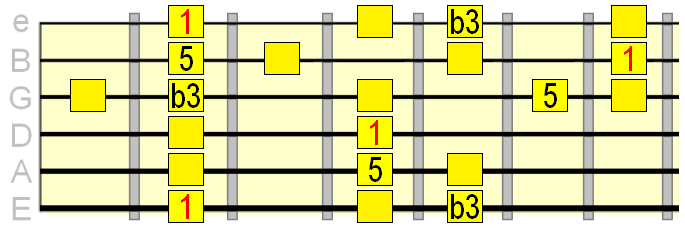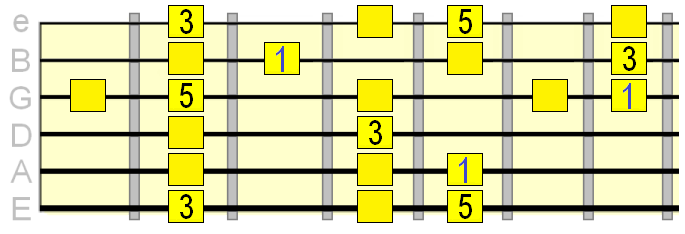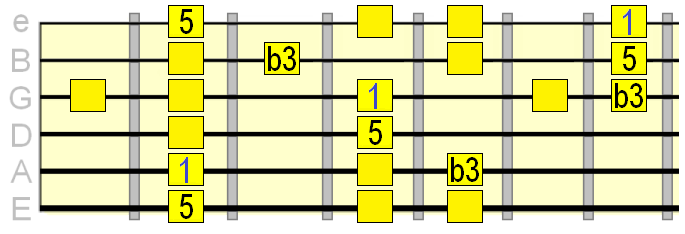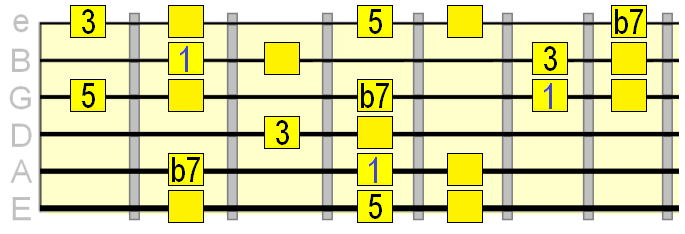Home
> Scales
> Natural & Harmonic Minor
The difference between the two scales is just one note, so the interplay between them can be subtle and therefore overlooked. This lesson, with the aid of a "guided jam track" will train your ear to hear this change and get you playing between natural and harmonic minor confidently and melodically.
The guided jam track can be found in the video below - watch the scale diagrams change with the track. See further down for static diagrams and to download the track in different keys...
Identifying Natural & Harmonic Minor Changes
In many minor key progressions, natural
minor will be the predominant
harmonization. In other words, most minor key chords will
include notes
from the natural minor scale.
It's when a major V
(5) chord is used that we change from natural to harmonic minor, as
this accomodates the major 3rd of that chord. This is a common
occurence in minor keys because that major 3rd carries a strong
harmonic tension (hence harmonic
minor!) that has a leading effect when resolved to the tonic i
(1) chord.
The table to the right shows you this major V harmonic minor chord in relation to several minor keys.
You can also play harmonic minor over the tonic chord, and other minor key chords (as natural and harmonic minor share some of these), but this will give you a very specific sound that might not be compatible with the effect you want. As always, experimentation is the key.
 Download Am Track -
Chords: Am
/ Fmaj / Dm / Emaj
Download Am Track -
Chords: Am
/ Fmaj / Dm / Emaj
 Download Em Track -
Chords: Em
/ Cmaj / Am / Bmaj
Download Em Track -
Chords: Em
/ Cmaj / Am / Bmaj
 Download Cm Track -
Chords: Cm
/ Abmaj / Fm / Gmaj
Download Cm Track -
Chords: Cm
/ Abmaj / Fm / Gmaj
For A minor, position the 1 of both patterns at the 5th fret (A).
For E minor, 12th fret (and open, as the 6th string is the note E!)
For C minor, 8th fret
Remember to start with just playing the chord tones and gradually build your two, three, four etc. note phrases from the scale, bridging these chord tones with varied scale movements. The most effective way to learn how to improvise is to simply explore your own movements freely and listen attentively to the results.
Repeat what you like the sound of and even tab it out as a lick. Then try to add more "feel" and embellish your phrases using bends, slides, legato and other lead techniques (see the lead section on this site for those). We'll look more in depth at developing our phrasing in a separate lesson.




The V chord major 3rd can be visualised as the 7th tone of harmonic minor, which means it has a leading effect towards the 1 (root) of the scale. Resolving to the root of the scale from the 7th (one semitone below the root) has a natural voice leading effect that you might want to make use of.
You can also insert other scale tones between this 7 > 1 resolution. For example, 7 > 2 > 1 / 7 > b3 > 1 / 7 > 5 > 1
That's how to build melodic phrases through chord changes - find a movement between two notes that work (i.e. two chord tones) and then bridge them using other tones from the scale, trying different approaches and combinations.
As demonstrated in the video, certain colour tones also sound good as chord target notes. The 2nd tone of the natural minor scale, for example, works beautifully over the first three chords in our sequence and gives you a more "outside" sound. So over the A minor track that would be the note B.
I hope you enjoy using the tracks and I have no doubt you will develop more confidence with improvising in minor keys as a result.
Share your thoughts...
Have any questions, thoughts or ideas about this lesson? Let us know using the comments form below.
 When
to Play Harmonic Minor - 5 Approaches
When
to Play Harmonic Minor - 5 Approaches
Natural & Harmonic Minor Scale Interchange - A Guided Jam
Most minor key songs and progressions are formed around the harmonization (e.g. chords) of two staple scales - natural minor and harmonic minor.The difference between the two scales is just one note, so the interplay between them can be subtle and therefore overlooked. This lesson, with the aid of a "guided jam track" will train your ear to hear this change and get you playing between natural and harmonic minor confidently and melodically.
The guided jam track can be found in the video below - watch the scale diagrams change with the track. See further down for static diagrams and to download the track in different keys...
Identifying Natural & Harmonic Minor Changes
In many minor key progressions, natural
minor will be the predominant
harmonization. In other words, most minor key chords will
include notes
from the natural minor scale.| Key | Tonic (i) | Dominant (V) | Audio |
| Am | Am A Natural Minor |
Emaj or E7 A Harmonic Minor |
Click here |
| Cm | Cm C Natural Minor |
Gmaj or G7 C Harmonic Minor |
Click here |
| Em | Em E Natural Minor |
Bmaj or B7 E Harmonic Minor |
Click here |
| F#m | F#m F# Natural Minor |
C#maj or C#7 F# Harmonic Minor |
Click here |
The table to the right shows you this major V harmonic minor chord in relation to several minor keys.
You can also play harmonic minor over the tonic chord, and other minor key chords (as natural and harmonic minor share some of these), but this will give you a very specific sound that might not be compatible with the effect you want. As always, experimentation is the key.
Minor Key Backing Tracks with Major V Chord
Below you can download the track featured in the video in three common minor keys - Am, Em and Cm. Remember, the first chord in the sequence is our tonic chord, the root on which we build our minor scales. The final chord in the sequence is our major V chord, where we make the change to harmonic minor. Download Am Track -
Chords: Am
/ Fmaj / Dm / Emaj
Download Am Track -
Chords: Am
/ Fmaj / Dm / Emaj Download Em Track -
Chords: Em
/ Cmaj / Am / Bmaj
Download Em Track -
Chords: Em
/ Cmaj / Am / Bmaj Download Cm Track -
Chords: Cm
/ Abmaj / Fm / Gmaj
Download Cm Track -
Chords: Cm
/ Abmaj / Fm / GmajNatural & Harmonic Minor Scale Patterns
These are the same diagrams shown in the guided jam video. Again, I've marked on the chord tones for each chord in the sequence, so you can build your phrases more melodically around the chord changes. Some people refer to these as "target notes", because they give your scale movements a sense of direction and purpose.For A minor, position the 1 of both patterns at the 5th fret (A).
For E minor, 12th fret (and open, as the 6th string is the note E!)
For C minor, 8th fret
Remember to start with just playing the chord tones and gradually build your two, three, four etc. note phrases from the scale, bridging these chord tones with varied scale movements. The most effective way to learn how to improvise is to simply explore your own movements freely and listen attentively to the results.
Repeat what you like the sound of and even tab it out as a lick. Then try to add more "feel" and embellish your phrases using bends, slides, legato and other lead techniques (see the lead section on this site for those). We'll look more in depth at developing our phrasing in a separate lesson.
i chord

VI chord

iv chord

V chord
Here's the change to the harmonic minor pattern. I've added in the minor 7th (b7) tone as this also has a strong harmonic connection to the V chord (which is commonly played as a dominant 7th chord, e.g. E7).
Tips for Smooth Melodic Changes
As mentioned, the major 3rd of the V chord (e.g. Emaj in the key of Am) is a strong harmonic tone. That doesn't mean you always have to emphasise that note in your melody, but just including it will give it some nice colour. To many musicians and listeners, touching on that major 3rd is like scratching an itch!The V chord major 3rd can be visualised as the 7th tone of harmonic minor, which means it has a leading effect towards the 1 (root) of the scale. Resolving to the root of the scale from the 7th (one semitone below the root) has a natural voice leading effect that you might want to make use of.
You can also insert other scale tones between this 7 > 1 resolution. For example, 7 > 2 > 1 / 7 > b3 > 1 / 7 > 5 > 1
That's how to build melodic phrases through chord changes - find a movement between two notes that work (i.e. two chord tones) and then bridge them using other tones from the scale, trying different approaches and combinations.
As demonstrated in the video, certain colour tones also sound good as chord target notes. The 2nd tone of the natural minor scale, for example, works beautifully over the first three chords in our sequence and gives you a more "outside" sound. So over the A minor track that would be the note B.
I hope you enjoy using the tracks and I have no doubt you will develop more confidence with improvising in minor keys as a result.
| Was this
helpful? Please support this site. I really appreciate it! |
Stay updated
and learn more Sign up to the newsletter for updates and grab your free Uncommon Chords book |
Share your thoughts...
Have any questions, thoughts or ideas about this lesson? Let us know using the comments form below.
Related
 When
to Play Harmonic Minor - 5 Approaches
When
to Play Harmonic Minor - 5 Approaches








